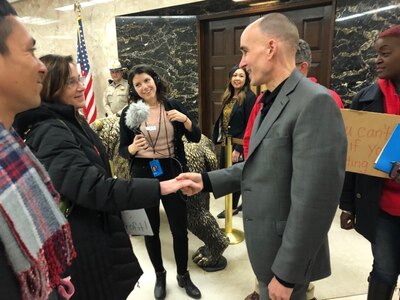Eyana Spencer, the child of a union activist and a former Black Panther organizer, grew up with a mantra: Never cross a picket line, no matter whose it is.
Now the principal of Manzanita Community School in Oakland, Spencer is mapping out how she and one assistant principal can keep the elementary campus running when Oakland Unified teachers strike on Thursday. She’s dreading having to walk past her picketing staff.
“It’s very hard,” she said. “It makes me feel nervous and uncomfortable in my heart. It’s something we don’t do in my family.”
As Spencer and dozens of fellow principals in the Oakland Unified School District plan for the unknown — How many students and staff will show up at school? How do we teach without teachers? How do we preserve our school’s camaraderie? — they’re also grappling with their own convictions, mixed feelings, and myriad worries. Before they became principals, several were teachers union leaders themselves. All sympathize with teachers, who are demanding higher salaries, smaller classes, and more specialists like counselors and nurses.
Teacher salaries in Oakland range from $46,600 to $83,700, some of the lowest in the area, at a time when a tech-fueled real estate boom has priced out even middle-income workers. The district has offered a retroactive 5 percent raise over three years; the Oakland Education Association wants 12 percent over the same period.
Oakland also faces financial challenges confronting many school districts in California and beyond. School enrollment is shrinking, largely because of competition from charter schools, as pension obligations grow. The district underwent a state takeover and financial bailout, but it now faces a $22 million deficit. Another state bailout requires school closures and other cuts, sparking more opposition from educators and families.
Energized by recent strikes from Los Angeles to Denver, the union has drummed up support with rallies and its signature “Red for Ed” T-shirts. The labor-friendly East Bay community has responded enthusiastically.
All of that has conspired to place new demands on the district’s more than 80 principals. As middle managers, principals are used to scrambling to fill the gap between what district administrators want and what parents, students, and teachers expect — a sometimes huge chasm in Oakland. The impending strike has ratcheted up pressure from all sides, multiplied principals’ duties, and positioned them in the unwelcome role of adversary to the people they still work to support.
“Everybody is trying to figure it out. It’s a tricky space to be in,” said Carmelita Reyes, principal of Oakland International High School.
The district plans to keep schools open, according to a spokesman. But many parents have pledged to keep their children home, as the union wants. Meanwhile, principals have strategized about how to teach those who show up on campus.
“I feel very strongly that if a parent sends a child to school, our doors need to be open for that child,” said Reyes, in her 12th year as principal. She’s planning for contingencies.
“I have a Plan A, Plan B, Plan C and Plan D,” she said.
While the school’s 25 teachers will likely walk out, it’s unclear what another 25 support staffers — custodians, food service workers, aides — plus others like coaches, tutors, and parent educators will do.
Supervision and attention to detail are paramount in the school of 400 students, all refugees and new immigrants. Many of them have endured trauma, are medically fragile, or are tenuously settling into this country. For a large number, Oakland International serves as family, providing critical mooring and support.
In the run-up to the strike, Reyes and two administrators have been convening groups and putting details into shared Google documents, charting what people plan, and what they know, and what they fear. They’ve held more than 50 one-on-one chats.
“I haven’t done my normal job for two weeks,” she said.

To an already burdened corps of managers, the potential conflicts and the uncertainty can feel overwhelming.
“The only way to make it through something like this is to have close relationships with other principals,” said Amie Lamontagne, principal of Korematsu Discovery Academy, a K-5 school in East Oakland. “We’re leaning heavily on each other.”
They’re sharing information and lesson plans, some seizing on a teachable moment to focus on unions, strikes, and advocacy. They’re making lesson packets for reading, math, and art.
But they don’t know how many students will attend, especially if the strike stretches beyond this week. Attendance will likely vary by neighborhood.
Parents at Crocker Highlands Elementary — where just 1 percent of the students are English learners — in the Oakland Hills are busy arranging to share care and transportation, and are likely to keep their children out of school.
In contrast, families at the International Community Elementary School, where 91 percent live in poverty in Oakland’s Fruitvale neighborhood, have less leeway to arrange impromptu childcare. Principal Eleanor Alderman has reached out to parents of the 300 students — about 80 percent of whom speak Spanish, while 15 percent speak Mam, a Guatemalan Mayan language, and another 5 percent Arabic, Dari, Farsi, or Tagalog.
While she doesn’t know how many children she’ll have to teach, she does know she can count on only a few adults Thursday: “Just me, the custodian, security guard, nutrition aide, and two from central office.”
In terms of concerns, managing school logistics pales in comparison to the potential fallout from a strike.
“My biggest concern is the impact on the community afterward,” Lamontagne of Korematsu said. She doesn’t know what students will feel crossing a picket line. And, she said, “I don’t know how adults are going to feel about each other.”
The aftermath could bring more tension — as schools in Denver, where teachers struck for three days last week, are now addressing. The district has indicated it will fund teacher raises in part by cutting central office staff, which will trigger “bumping” by senior employees displacing junior workers. The practice could stir anger and resentment among lower-paid support staff toward higher-paid teachers.
District veterans recall the bitterness that festered for years after a five-week strike in 1996. Even a one-day strike a decade later took a toll.
“I was on the picket line in 2010,” said Alderman, who was a teacher at the time. “My relationship with my principal was ruined that year. And it never recovered.”
Now a principal, she’s made a point of telling her staff that she’s been in their shoes, and will do everything she can to support them on strike. She plans to bring coffee and donuts, and let picketers use the school restrooms.
The best outcome, said Joci Kelleher, principal of Crocker Highlands Elementary, will be if the district awards teachers a livable wage and also remains solvent.
Even that may not produce a net win for schools and students, principals privately fear.

“Principals know 100 percent if we do end up providing a raise, that that money is going to get taken out of the site budgets for next year,” Alderman said. That would slash social workers, teacher leaders and other critical support for students and staff.
With attention focused on their district, Oakland principals have seized the opportunity to write an op-ed piece, signed by 75 of them, pressing California to boost education spending.
“I worry about the fact that we can’t keep teachers in Oakland because the pay is abysmal,” Kelleher said. Annual teacher turnover is about 18 percent.
On Wednesday, more than 30 principals are traveling to Sacramento to lobby legislators to raise state funding for schools, and especially to forgive Oakland Unified’s $36 million debt left from a 2003 bailout.
“No current students were even in school in 2003 when the debt was incurred,” said Principal Clifford Hong of Roosevelt Middle School. “Most weren’t even born.”
At stake, some realize, not only are the independence of their district and the jobs of Oakland teachers, but also their own jobs.
“Our working conditions are not sustainable. I’m afraid we will see a big turnover in next year or two years,” said Spencer, now in her 13th year at Manzanita elementary. “We have people who deeply love and care about their school communities — but also have to care for their families.”


